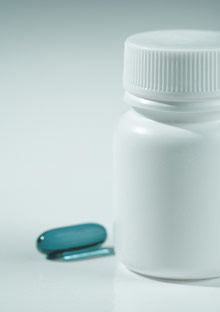Are You Taking Unsafe Prescription Drugs?

Photo: © 2009 Jupiterimages Corporation
Pardon us for peeking inside your medicine cabinet, but are you taking the hot-flash drug Estratest? Using Hylira, a prescription-only dry-skin gel? Or dosing your kids with Carbofed DM syrup for their sniffles? You should know that these products—and thousands more—have never been approved by the U.S. Food and Drug Administration. Yet doctors write an estimated 70 million prescriptions for such drugs each year; they're sold in pharmacies, and they're even covered by health insurance.
Unapproved drugs exist in a sort of legal limbo. "They have names and packaging that look just like approved drugs, and they're even in the Physicians' Desk Reference," says Patti Manolakis, a Charlotte, North Carolina–based health policy consultant who has studied and written about the issue. "Some came on the market before 1962, when the FDA's approval rules changed dramatically. Others have been introduced since then, flying under the radar." For example, drug companies sometimes market copycats of approved drugs—a practice that's been allowed under federal guidelines, provided the company submits data on the drugs' safety and efficacy. But many companies never send in the data, and the FDA has been too overtaxed to police scofflaws.
But that's changing. As part of an initiative to bring unapproved drugs into compliance or remove them from the market, the FDA recently banned some of the most dangerous unsanctioned medications—including cough-and-cold drugs containing the ingredient carbinoxamine, associated with the deaths of 21 children; quinine products for leg cramps, which may have killed 93 adults; ergotamine tartrate for migraines, which lacked warnings about potentially fatal drug interactions; and the highly toxic drug colchicine, reportedly linked with 23 deaths when used intravenously for back pain.
Deborah Autor, director of compliance for the FDA's Center for Drug Evaluation and Research, says it's not as simple as just sweeping all unapproved drugs off the market. "Some drugs, such as phenobarbital for seizures, may be medically necessary."
Among the most popular unapproved drugs still available are estrogen-plus-testosterone pills, which are marketed as hot-flash remedies. Doctors wrote 1.8 million prescriptions for these drugs in 2008, despite the FDA's 2003 findings that there wasn't enough evidence the hormonal cocktail works. And it may raise the risk of breast cancer, liver problems, and depression.
"People tend to assume that if a drug is available in the U.S., it's safe and it works," says Amy Allina, program director of the Washington, D.C.–based National Women's Health Network. "But there are too many examples of products that have done real harm." You can protect yourself by looking up the names of medications you and your family take in the FDA's database (www.fda.gov/cder/ndc/index.htm). The drug should have a number under the heading "Appl No" (it stands for "application number"). "If you see the word other," Manolakis says, "call your doctor and ask for an approved drug for the same condition. I do it all the time for myself and my three children."
Unapproved drugs exist in a sort of legal limbo. "They have names and packaging that look just like approved drugs, and they're even in the Physicians' Desk Reference," says Patti Manolakis, a Charlotte, North Carolina–based health policy consultant who has studied and written about the issue. "Some came on the market before 1962, when the FDA's approval rules changed dramatically. Others have been introduced since then, flying under the radar." For example, drug companies sometimes market copycats of approved drugs—a practice that's been allowed under federal guidelines, provided the company submits data on the drugs' safety and efficacy. But many companies never send in the data, and the FDA has been too overtaxed to police scofflaws.
But that's changing. As part of an initiative to bring unapproved drugs into compliance or remove them from the market, the FDA recently banned some of the most dangerous unsanctioned medications—including cough-and-cold drugs containing the ingredient carbinoxamine, associated with the deaths of 21 children; quinine products for leg cramps, which may have killed 93 adults; ergotamine tartrate for migraines, which lacked warnings about potentially fatal drug interactions; and the highly toxic drug colchicine, reportedly linked with 23 deaths when used intravenously for back pain.
Deborah Autor, director of compliance for the FDA's Center for Drug Evaluation and Research, says it's not as simple as just sweeping all unapproved drugs off the market. "Some drugs, such as phenobarbital for seizures, may be medically necessary."
Among the most popular unapproved drugs still available are estrogen-plus-testosterone pills, which are marketed as hot-flash remedies. Doctors wrote 1.8 million prescriptions for these drugs in 2008, despite the FDA's 2003 findings that there wasn't enough evidence the hormonal cocktail works. And it may raise the risk of breast cancer, liver problems, and depression.
"People tend to assume that if a drug is available in the U.S., it's safe and it works," says Amy Allina, program director of the Washington, D.C.–based National Women's Health Network. "But there are too many examples of products that have done real harm." You can protect yourself by looking up the names of medications you and your family take in the FDA's database (www.fda.gov/cder/ndc/index.htm). The drug should have a number under the heading "Appl No" (it stands for "application number"). "If you see the word other," Manolakis says, "call your doctor and ask for an approved drug for the same condition. I do it all the time for myself and my three children."



